 As the pandemic forced some clinical trial sites to shut down and numerous ongoing studies to pause, patient recruitment also slowed to a crawl, piling one more challenge onto an area that traditionally is fraught with difficulty. According to the Center for Information & Study on Clinical Research Participation (CISCRP), roughly half of clinical trials either under enroll patients or fail to enroll a single patient, and there is a 30% patient dropout rate across clinical trials.
As the pandemic forced some clinical trial sites to shut down and numerous ongoing studies to pause, patient recruitment also slowed to a crawl, piling one more challenge onto an area that traditionally is fraught with difficulty. According to the Center for Information & Study on Clinical Research Participation (CISCRP), roughly half of clinical trials either under enroll patients or fail to enroll a single patient, and there is a 30% patient dropout rate across clinical trials.
Despite these challenges, the pandemic has also had a positive effect on the patient recruitment process. More is being done digitally, both on the recruitment and retention sides, and the harsh impact COVID-19 has had on minority communities has the industry placing diversity front and center in their recruiting efforts.
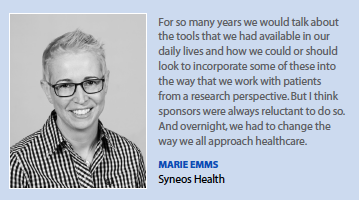 Marie Emms, VP of site and patient access at Syneos Health, notes that the COVID-19 pandemic forced the clinical trials industry to change overnight.
Marie Emms, VP of site and patient access at Syneos Health, notes that the COVID-19 pandemic forced the clinical trials industry to change overnight.
“For so many years we would talk about the tools that we had available in our daily lives and how we could or should look to incorporate some of these into the way that we work with patients from a research perspective," Ms. Emms says. “But I think sponsors were always reluctant to do so. And overnight, we had to change the way we all approach healthcare.
“In some ways, when patients were forced into new ways of participating in clinical trials, there were actually some things that they were okay with and that made it easier for them to look after their own health," she continues. “It made it easier for them to be part of a study from home where they were not being put at risk."
Even with the pandemic easing up, Ms. Emms says there is still an element of fear when it comes to patients seeing their doctors in person. “It’s great that we have vaccines and the lessening of lockdowns on the horizon, but there is  still that reluctance," she says. “I believe this will continue, and I think as an industry, we need to work out what we can do to actually support our pharmaceutical clients, our sponsors, sites, and patients, such as being able to participate in research but not actually having to physically go to a site to do so."
still that reluctance," she says. “I believe this will continue, and I think as an industry, we need to work out what we can do to actually support our pharmaceutical clients, our sponsors, sites, and patients, such as being able to participate in research but not actually having to physically go to a site to do so."
Rosemary Lakeru, director of patient recruitment, feasibility, and diversity at Couch Health, says the pandemic has contributed to innovation around the ways patient recruitment is conducted.
“One of the major shifts we experienced is the growth and implementation of decentralized trials being an option in the study design," Ms. Lakeru says. “This has given sponsors an opportunity to continue recruiting for their trials without major delays."
Melynda Geurts, senior vice president, business operations at Total Clinical Trial Management, says the COVID-19 pandemic has had some positive impact on the clinical trials industry by pushing sponsor companies to reevaluate how they conduct clinical trials and how study designs impact study participants.
“I do believe, and hope, that the adoption of hybrid and decentralized services will 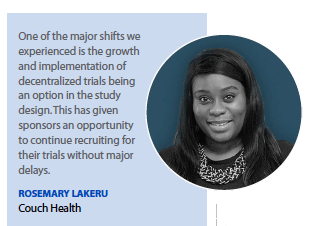 remain intact," she says. “The bar in study participation has been raised, and I’m not entirely sure we can step back or afford to."
remain intact," she says. “The bar in study participation has been raised, and I’m not entirely sure we can step back or afford to."
Rod MacKenzie, Ph.D., chief development officer and executive VP at Pfizer, says COVID-19 must be a catalyst for modernizing the way clinical trials and recruitment are conducted.
“We were able to move with lightning speed to address the pandemic with vaccines, but it also highlighted the many outdated technical infrastructures established years ago for clinical trials, especially with regard to digital capabilities," Dr. MacKenzie says. “We must capitalize on this chance to entrench the improvements made during the COVID-19 pandemic on behalf of all patients, especially those with life-threatening conditions and no other outcomes."
Victoria DiBiaso, global head of patient informed development & health value translation at Sanofi, says the pandemic has reinforced her company’s long-standing commitment to ease the burden of clinical trial participation as well as further integrate a patient-centric focus across all of R&D.
“The pandemic has amplified the need to ensure mechanisms exist to increase representativeness in our studies," Ms. DiBiaso says. “For several years, it has been a mainstay of our programs to leverage real-world evidence as part of optimizing eligibility criteria, plus we work directly with trial sites and patients to pressure test draft designs and recruitment and retention strategies."
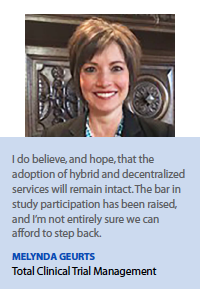 “We believe the altruistic drive to participate in clinical research for the greater good is stronger than ever because of the intense focus on the important work we’re doing," says Jill Pellegrino, senior VP and general manager, Accelerated Enrollment Solutions, a business of PPD. “The significance of that work needs to be emphasized when we engage with potential trial participants."
“We believe the altruistic drive to participate in clinical research for the greater good is stronger than ever because of the intense focus on the important work we’re doing," says Jill Pellegrino, senior VP and general manager, Accelerated Enrollment Solutions, a business of PPD. “The significance of that work needs to be emphasized when we engage with potential trial participants."
Technology on the Rise
Ms. Pellegrino says the pandemic has reemphasized the importance of ensuring trial design and patient recruitment strategies result in representative populations participating in clinical trials. It has also led to adoption of more patient-centric technologies — such as devices and wearables, televisits, eConsent, and remote monitoring — at a much more rapid rate than planned.
“Virtualization of first office visits to limit travel and aid social distancing, home visits, and delivery of investigational products are all becoming common across trials," she says. “We will increasingly engage with potential participants through technology and virtual platforms, both during recruitment and trial participation."
Dr. MacKenzie says the continued digital transformation for participants in clinical trials is important for improving access, speed, quality, and the overall participant experience.
“More and more trials are making items such as wearables and electronic diaries available, and novel approaches, including image collection by smartphone, telemedicine engagements, and remote monitoring informed by advanced analytics, are all increasingly part of clinical trial engagements," he says.
According to Dr. MacKenzie, a key issue that remains is that most people simply don’t know that participation in a trial is an option for them. To that end, he says, Pfizer has made a commitment to increase awareness and support its clinical trial sites, recruit participants, and provide access to its studies. One way the company has done this is by launching a website, PfizerClinicalTrials.com, to offer potential volunteers a central location to get information on clinical trials and how to participate.
 Ms. DiBiaso says the pandemic has prompted Sanofi to permanently build agility into its studies by establishing robust decentralized capabilities such as telemedicine-enabled study visits, at-home data collection through ePROs, and direct-to-patient IP delivery, and focusing on study procedures that mirror the standard of care.
Ms. DiBiaso says the pandemic has prompted Sanofi to permanently build agility into its studies by establishing robust decentralized capabilities such as telemedicine-enabled study visits, at-home data collection through ePROs, and direct-to-patient IP delivery, and focusing on study procedures that mirror the standard of care.
“This includes improving how we engage with patient communities overall through improved trial awareness and online screening platforms," she says. “We are partnering with patient groups and community stakeholders to improve how we communicate and build trust around the clinical trial process plus proactively understanding the support patients need to participate. We are also investing the use of wearables for real-time generation of patient health data."
Another area where digital is playing an increasingly prominent role is in the recruiting process itself. Ms. Geurts says online outreach is a highly effective way to reach study participants.
“In the pre-pandemic era, more than 75% of the public obtained healthcare information through a social platform, and this percentage has continued to rise now as more and more people are having to embrace telemedicine visits and a more virtual world," she says. “It’s not the only platform to consider but it remains the top runner."
Ms. Emms says Syneos Health often uses digital to help its selected sites get beyond their local radius and patient databases. However, she notes that sometimes it’s more effective to go through advocacy groups. “The advocacy groups themselves might be doing more digital and social media-based targeting — it’s three of the channels that we use and how we’re using them," she says. “And whoever is driving that traffic determines its effectiveness."
Ms. Lakeru says she often refers to digital advertising as casting a strategic wide net into the world.
“This approach allows us to engage with various patient populations in areas of the world that we do not necessarily have to be in," she says. “Having said this, I do believe the way in which digital advertising is approached is changing and we will see a significant shift as to the social platforms and community group channels used to engage more patient/social and community influencers."
Tricia Barrett, chief operating officer at Praxis Communications, notes that using digital advertising for recruitment is nothing new, but the level of targetability does differ across the digital landscape.
“Search engine advertising allows us to geotarget ads based on a word or phrase someone searched for, so these should be the low-hanging fruit," Ms. Barrett says. “Advertising on social media platforms, where geotargeting allows us to reach potential participants who have an interest in a relevant condition or otherwise qualify based on demographics, is another effective strategy.
“After maximizing opportunities with paid search and social, additional digital tactics such as online displays and streaming audio/videos can be considered to broadly target a user’s online behavior as an indicator that they may have an interest in a specific medical condition," she adds.
Ed Ikeguchi, M.D., CEO of AiCure, says using mechanisms like search engines and social media to get patient recruitment messages out “certainly throws out a bigger net. And I do think that it will be and should be effective at recruiting more participants, or at least feeding a larger funnel at the top."
However, Dr. Ikeguchi questions whether these efforts will bring in engaged clinical trial patients who are committed to sticking with the trial until the end. “I have a friend who was recently enrolled in a COVID study, and she said it was so easy to enroll online and through telemedicine," Dr. Ikeguchi says. “And the fact that she had so little skin in the game in enrolling made it really easy for her to just drop out when she decided she didn’t want to be in the trial anymore. Because she didn’t see anyone in person, and it was all done virtually and electronically, it was just as easy for her to drop out as it was for her to enroll.
“So, I do wonder about how we can serve to deliver better engagement with patients who are participating in clinical trials," he continues. “Especially now with this pandemic, with telemedicine, they don’t aim to actually physically see patients in the clinic as often anymore. Traditionally, with every dose, we’re right there in front of the patient, and in everything from adverse events to typical ePRO or the questionnaire they’re filling out, we have an opportunity to press the flesh. With telemedicine, you just don’t get that connection."
Dr. Ikeguchi does recommend a few ways to help increase engagement in these circumstances.
“At AiCure, we’re heavily involved in strategies around keeping patients engaged," he says. “Not just through using an app to determine whether a patient has swallowed a pill, but gauging how the patient is doing. Are they achieving the goals that they wanted in enrolling in a clinical trial? Can we give them micro-reimbursements for every time they dose? And importantly, can we use behavioral science to accurately predict when a patient is considering leaving a trial? It’s not a binary thing where one day, patients want to be on the trial and the next day they’re just quitting cold turkey. Usually, it starts out with, ‘I’m really not sure about this,’ and continues in varying degrees until they say, ‘Okay, I’m gone.’ We can predict which patients are likelier to drop out than others with fairly high degrees of accuracy using some of these predictive algorithms we have built."
Ensuring Diversity in Recruitment
Diversity in clinical trials remains a thorny problem, one the industry is actively trying to solve. Ms. Geurts thinks the industry is taking the right steps overall to ensure diversity in clinical trials, but that this long-rooted obstacle is not one that will be overcome quickly.
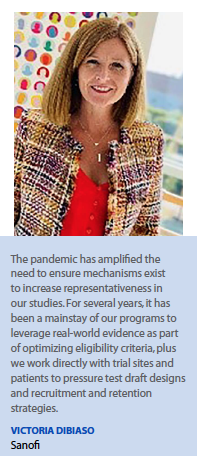 “In the last year, many professional organizations have bandned together to define and outline strategies to change processes to increase diversity in clinical trials," she says. “In short, education remains the key to ensuring this endeavor is successful. The industry needs to remain vigilant in its efforts in making this change."
“In the last year, many professional organizations have bandned together to define and outline strategies to change processes to increase diversity in clinical trials," she says. “In short, education remains the key to ensuring this endeavor is successful. The industry needs to remain vigilant in its efforts in making this change."
Ms. Lakeru says she has noticed an accelerated effort by the industry to improve clinical trial diversity. “I see more protocols including the need to involve people from racial or ethnic backgrounds, more conversations are being had, and more partnerships are being formed in the collective drive to improve diversity and inclusion (D&I) attitudes within organizations, and support for investigative sites with D&I-specific training," she says. “A lot more can be done to ensure representation is reflective of us all, which should not be limited to race or ethnicity but thinking about wider cultural factors such as socioeconomic backgrounds, gender, and the abilities of participants. There should also be a global industry standard to ensure that the quality of D&I data in clinical trials is of good standard."
Ms. Emms says while she thinks some individual organizations are further ahead than others, she believes the industry as a whole is starting to have a larger focus on diversity. She says as part of Syneos Health’s diversity, equity, and inclusion council, they keep the patient at the heart of all their discussions.
One of the challenges she cites is simply finding more diverse patients. “Now we’re at the point where protocols are much more targeted to individual patients with specific biomarkers or genotypes, and we need to dig deeper to find those patients," she says.
“From a diversity perspective, we’re looking for patients who might not even be in the healthcare system. Some of these patients don’t have access to healthcare, or they don’t have the ability to take time off from their jobs, or they don’t have transportation available.
“The first step is to help those patients get access to these studies," she continues. “The other part is being able to ensure that we’re giving those patients the tools to participate, whether that’s working with a home health team to ensure they can come locally to patients to help with some of the tests that perhaps they would need to go to an office for, or we’re helping with transport, or they’re being reimbursed for any travel costs they incur in a timely manner."
Blaine Cloud, Ph.D., president of Clinical Score, says diversity can be a tricky issue, and that the response to their efforts has sometimes been surprising.
“When we talk to patients about how do we make it more enticing for you as a member of a diverse population, they often will say, ‘I don’t want to be treated any differently,’" he says.
“That would be more off-putting than doing nothing or the site doing something that’s going to make me feel different. We have to be really careful not to be too heavy-handed with trying to cater to diverse populations, because then they feel that same difference that they don’t want to feel.
“Now on the flip side of that, as advertisers and marketers who are recruiting patients and clinical trial sites trying to get a more diverse study populations, they need to make sure that diversity is somehow subtly messaged in the recruiting materials," he continues. “But again, it can’t be too over the top because then it just becomes off-putting. It’s a fine balance that needs to be struck."
Dr. MacKenzie says ensuring diversity of volunteers in clinical trials is not only a matter of equity — it’s good science.
“At Pfizer, we have made public our commitment that we will recruit clinical trial populations that represent the racial and ethnic diversity of the countries we operate in," he says. “We want to make it easier for people living in communities that have been historically underrepresented to volunteer and are engaging with diverse healthcare providers more than ever. We are also closely partnering with sites and providing tools and information to principal investigators and study managers to help them enhance their own recruitment efforts. Finally, and importantly, we are making our expectations in this area very clear to all of our investigators and sites who participate in our studies.
“Overcoming barriers and challenges to fair representation in clinical trials won’t happen overnight, nor can it be achieved by a single company," he continues. “Meaningful and sustainable changes in the way we conduct and design clinical research will require both commitment and investment from pharmaceutical companies and the broader research and medical communities."
Dr. Cloud thinks an industry-level PSA about clinical trial diversity would also help. “It just doesn’t seem like that messaging will be totally effective just coming one-on-one from a clinical trial site to a patient," he says. “It feels like it needs to be a little bit up at a more mass-media level."
Ms. DiBiaso says she is proud of the industry’s focus on increasing diversity. “Companies are working closely together across various consortia and policies to bring forth effective solutions," she says. “At Sanofi, all of us place a significant priority on increasing diversity as part of reducing health disparity and inequity across our clinical trials. We are working directly with various community and patient organizations plus engaging with local trial sites and investigators to approach solutions together."
However, she does acknowledge the industry still has a lot to learn about the barriers to participation that some individuals face. “That translates into a need to develop tools to better identify barriers and provide meaningful solutions," she says. “I would also like to see technology capabilities evolve to allow us easier identification of those populations within a community of patients who are underrepresented and link it to their geographic location so that community support programs can be proactively customized with various stakeholders to help increase access and reduce health inequities."
Ms. Pellegrino observes the disproportionate impact of the COVID-19 pandemic on minority populations reemphasized the need for increased diversity and representation in clinical trials. “It has stimulated many discussions and increased awareness levels that have led to protocols becoming more prescriptive about the demographics of the trial participants," she says. “The last 12 months have seen great strides toward diversifying patient involvement, but there still is work to be done. Diversity and representation among our clinical trial workforce and increased engagement with community leaders, church groups, and healthcare providers in minority communities will be key. But, bottom line, building trust is essential to recruiting minority participants."
Dr. Ikeguchi agrees the industry still has a way to go in terms of clinical trial diversity. “At the heart of the problem when talking about enrolling patients of color in clinical trials, beyond access to care in rural areas or technology for virtual studies, is trust. There is this underlying thinking that dates right back to the days of the Tuskegee experiments. And there’s not a clear degree of engagement with the minority communities through trusted entities, mainly physicians of color, to engage with their patients and assure them it’s a good thing and appropriate to participate in clinical trials for their disease. We look at the number of participants who are minorities in clinical trials, but yet, we hardly ever look at the number of minority investigators participating in clinical trials, which is not large. That’s a good place to start, in my opinion."
Like most industries, Ms. Barrett says the life sciences has a long way to go in diversity, but the conversation is finally taking place. “It is also important to remember that diversity is the range of human differences and should be inclusive of so much more than skin color, including but not limited to race, ethnicity, age, geographical origin, gender/sexual orientation, religious beliefs, socioeconomic status, and so forth," she says.
“We also must recognize that within our clinical research industry there have been disparities and injustices towards certain racial/ethnic minorities in the past," she adds. “As an industry, we need to do better and heal those wounds. And now’s the time. The stage has been set for the conversation to continue and actions to take place."
The Future is Virtual
As the pandemic starts to wind down, some of the trends it has sparked are expected to remain in place. For instance, Ms. Geurts says she believes the continuation of blended services will remain a trend in clinical trials.
“As the focus on patient-centricity and diversity remain a primary focus for sponsor companies, hybrid services will continue to be offered and, in some instances, expected by study participants," she says.
Ms. Emms also thinks decentralized solutions will continue to gather momentum, since COVID has allowed the industry to have a greater focus on diversity.
“The other side I would look at in parallel is diversity and ensuring that we’re reaching truly reflective patient populations," she says. “Obviously, this means ensuring that we include patients who are reluctant to see their doctor because they don’t really have a strong relationship with them, or that they don’t actually have access to the healthcare that many of us have. Diversity is something that many of our largest sponsors are certainly focused on."
Ms. Emms observes that the industry is starting to realize it cannot use the same methods to fill studies as it has over the past 20 years or so. “We need to look at new ways of reaching patients because many of these patients will be in smaller local communities, and they don’t have the access to the healthcare that we would normally find patients through," she says. “And we need to look at different ways of finding those patients."
Dr. MacKenzie agrees that ensuring the recruitment of diverse and representative patient populations remains an industry imperative going forward. He cites another critical component of making trials more accessible by removing practical barriers, such as the inability to travel to a site. “Technology can help with this, and we are taking steps to reduce, or in some cases eliminate, the need to travel," he says. “We are also providing direct support to participants by offering to cover transportation costs and other impediments in joining a trial."
“I believe diversity in patient recruitment will become a core part of all patient recruitment outreach strategies, and that protocols will be designed with diversity in mind and more engagement with diverse community groups and leaders," Ms. Lakeru says. “I expect to see more inclusive practices that will bring the patient voice to all facets of clinical trials and finally see that they are treated as partners."
Ms. Lakeru also expects to see a rise in artificial intelligence being applied and used to recruit patients into trials in the next 12 months. “Also, the way patient data in a clinical trial is recorded and reported will see a global surge to standardized practices, quality, and process," she says.
“The trends I see are a continuation of things such as targeted social media, using the algorithms of Facebook and Instagram, to be able to deliver clinical trial ads at the right place and to the right people," Dr. Cloud says. “This is an increasingly effective way to do things. Over the course of the past year, study coordinators have 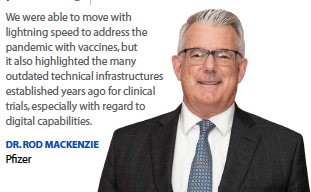 been telling us that they are less frequently using radio, TV, and the classic traditional print ads, because they’re getting diminishing returns from those efforts. But social media in particular, and digital campaigns in general, seem to be producing the best results for them."
been telling us that they are less frequently using radio, TV, and the classic traditional print ads, because they’re getting diminishing returns from those efforts. But social media in particular, and digital campaigns in general, seem to be producing the best results for them."
Dr. Cloud believes this trend has been accelerated by the COVID-19 pandemic, since people are online and on social media almost all the time.
Another thing Dr. Cloud sees happening as we come out of the pandemic is a bounce-back in patient recruitment referrals from physicians and hospital networks not affiliated with a particular clinical trial.
Dr. Cloud also foresees what he calls “a warehousing effect" in which patients with certain conditions who were not going in to see their doctor or hospital for diagnostic labs and tests will feel more comfortable getting them done as the pandemic winds down. And as they get those tests done and get a diagnosis, they’ll become eligible for referral to a clinical trial site.
“So, I can see not only a bounce-back in 2021, but it might be easier to get referrals because of that warehousing effect," he says.
Ms. Pellegrino expects to see an ongoing high demand in COVID-19 research for healthy volunteers and special populations, such as adolescents, children, and pregnant women.
“We foresee continuing and follow-on research on COVID-19 vaccines and therapeutics, including for COVID variants," she says. “We believe we will see a high interest in COVID-19 research outside the U.S. and in some European countries as vaccination rates increase. Further lockdowns or subsequent waves of COVID-19 infection could impact patient recruitment, but ever-increasing vaccination rates should provide a boost to patient willingness to participate in other non-COVID-19 clinical trials.
“The adoption of technology and the further virtualization of trials also will be a key trend in 2021 and beyond," she adds.
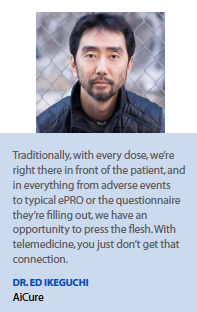 “We are still very much living in a COVID world, but as communities start to reopen and people start to feel more comfortable getting back into a routine, I think the future of clinical trials will be forever changed — or at least I hope they will," Ms. Barrett says.
“We are still very much living in a COVID world, but as communities start to reopen and people start to feel more comfortable getting back into a routine, I think the future of clinical trials will be forever changed — or at least I hope they will," Ms. Barrett says.
“Clinical trials have been given an international stage," she continues. “Participant recruitment for the COVID-19 vaccine trials happened at an astonishing speed. The public was aware of the opportunity, and the industry made it easy for individuals to participate: two things that I expect to continue as industry trends."
Ms. Barrett adds that the industry needs to create ample education and awareness of clinical trial opportunities. “We need to leverage the stage and promote the altruistic and scientific benefits of clinical research," she says. “We need to continue to make it easy for potential participants to find clinical trials opportunities. We also need to make it as easy as possible for a patient to participate. Patients and/or caregivers should have a seat at the table as part of the protocol development process and should have influence over how the trial design is constructed."
Dr. Ikeguchi says remote medicine and telemedicine have made it easier to access data around how patients are doing in a particular disease area. “This is criteria that might suit particular clinical trials in a particular patient, that they can get more in 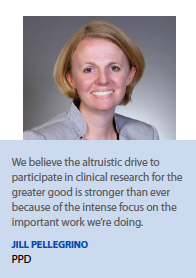 a timely fashion because of telemedicine," he says. “And I think this could be relevant to the future of recruitment."
a timely fashion because of telemedicine," he says. “And I think this could be relevant to the future of recruitment."
Ms. DiBiaso says Sanofi has a long-standing commitment of designing clinical trials around the patient as a whole person. “This includes a proactive evaluation of patient-centric dynamics in each clinical trial during the earliest stages of planning," she says.
“This is driven by our priorities to speed our development of meaningful new medications while ensuring diverse representation and inclusion within each program.
“With respect to emerging trends, I see a greater awareness towards the importance of designing studies with relevant outcome measures reflecting patient experience, incorporating behavioral sciences, further reducing burden through the use of patient-generated data sources, and the piloting of synthetic control arms to reduce the number of patients exposed to the placebo," she adds. “These elements will further support the relevance and ease of participation, thus positively impacting recruitment."(PV)


















